This post may contain affiliate links. I only recommend products or services that I personally use or trust, promise!

It’s finally here! My ALL TIME FAVORITE Korean street food is tteokbokki and I promise you this is the best recipe you will find on the internet. I love love LOVE spicy rice cakes and I am so excited to share the recipe I have been working on!
What is tteokbokki?
Tteokbokki is a very well known street food in Korea that is especially popular with students. The traditional version is made with rice cakes, fish cake, and sometimes hard boiled eggs, all cooked and drenched in a delicious spicy sauce that can be slightly sweet.
There are so many different kinds of tteokbokki now- you can add ramen noodles to them (cutely called ra-bokki), there are different versions of sauce like the new rose tteokbokki, and they often come in different types of combos that have dumplings, blood sausage, or tempura.

Ingredients:
- Rice cake- I prefer to use freshly made rice cakes that are made by a rice cake business and sold at the Korean supermarket- they are usually right at the front where the cash registers are. The vacuum sealed packs in the refrigerated section are fine too, but don’t get the frozen ones unless it is your only option. I prefer the freshly made ones because they are usually available in the really thick pieces. This is just a preference for me- I LOVE the thicker rice cakes because they are really chewy, and the recipe I have developed is 100% inspired by Baek Jong Won’s famous Igane Tteokbokki stall in Busan. They use thick rice cakes!
- Fish cake- you can use any shape fish cake you prefer. To keep it traditional, I am using the fish cake sheets and cutting them into triangles.
- Anchovy stock- I learned this part from my mom! She also loves tteokbokki and would always start it off by boiling some anchovies. It adds umami, and in my opinion it is extremely necessary.
- Sauce- the sauce is the most important element to this dish. I will go into more detail about the sauce later, but the ingredients are anchovy stock, extra spicy Korean pepper paste (gochujang), fine Korean pepper flakes (gochugaru), coarse Korean pepper flakes, soy sauce, light brown sugar, oligosaccharide, and a little msg (optional).
- Veggies- to make a really good tteokbokki, these veggies are absolutely necessary! You will need large green onion, cabbage, and Korean radish. I will go into more detail about the Korean radish later- pretty sure this is a new one to most people who have tried tteokbokki recipes before.
- Hardboiled eggs- this is optional but highly recommended. Hardboiled eggs dipped in tteokbokki sauce is a serious game changer. It also adds at least 1 healthy element to this dish, since tteokbokki is generally regarded as junk food in Korea.
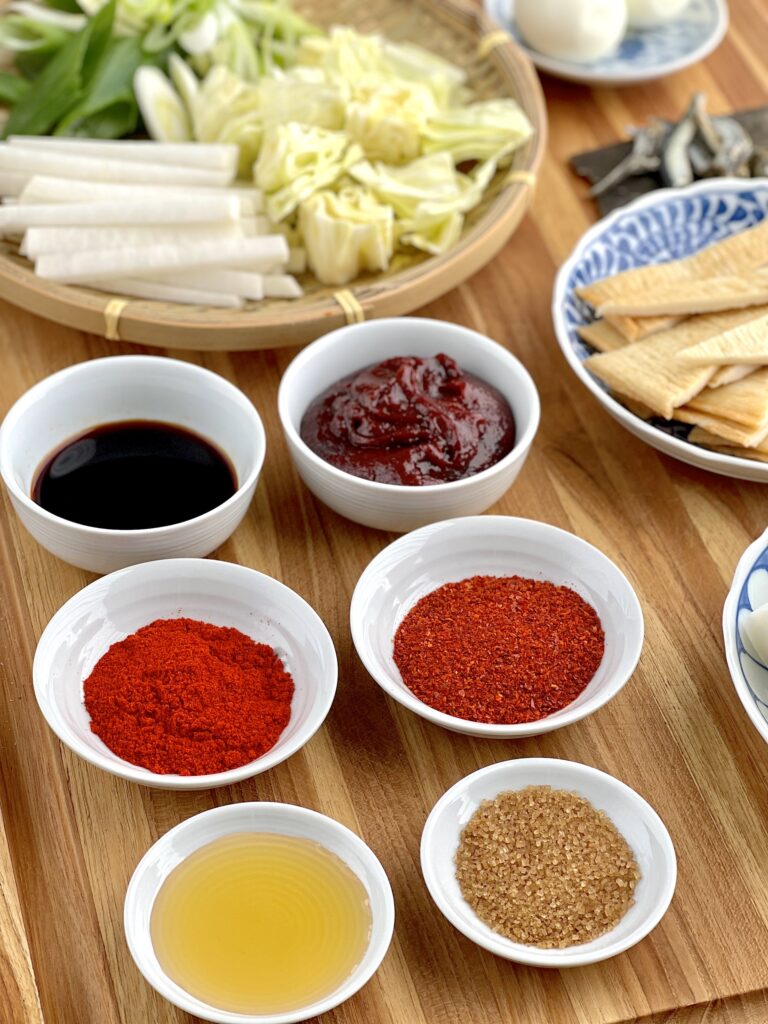
About the sauce
Color is not always a good indicator of how good/bad a sauce is, but I typically like to stay away from tteokbokki that is too light or orange in color. It has to be RED! To achieve the right color you’ll need lots of flavor from gochujang & 2 types of gochugaru- fine and coarse. The fine powder will dissolve better and create a beautiful rich red color while also adding flavor. The coarse gochugaru will not fully dissolve but still adds flavor, some color, and specks of powder that is typically seen on tteokbokki.
I also prefer tteokbokki that is VERY saucy. I make mine with plenty of sauce for 2 reasons. First, I usually have tteobokki with my other favorite street food, twigim. Twigim is like vegetable/seafood tempura and I love dipping it into the tteokbokki sauce. Korean pepper twigim is my absolute favorite but I also love yam and squid twigim!
Second, you can use the leftover sauce to eat with ramen! I sometimes boil some ramen noodles and then toss them into the tteokbokki sauce. With a hardboiled egg, it is soooo soo good!
I’d say there are three really important elements to a good tteokbokki sauce-
- Anchovy stock- if you’re a vegan and leave this out, it won’t be as good in my opinion but definitely don’t skip the msg in this case. It will help a lot.
- Sauce ratio- this will be different for every person depending on their taste. I personally do not like my tteokbokki to be that sweet, but it generally has a lot of sugar in it to balance out the spice. However, I like my tteokbokki spicy! I found that the best way to make it spicy but still have some sweetness to balance it out, is to use extra spicy gochujang and a combination of light brown sugar + oligosaccharide. I created the perfect ratio for my taste, but the “golden ratio” in Korea is considered to be equal parts gochujang, fine gochugaru, coarse gochugaru, soy sauce, and sugar.
- Korean radish- The radish is cut into thin strips then lightly stir fried in the sauce (with a small amount of anhovy stock) until some water is released and it turns slightly flexible. Then the rest of the anchovy stock is added. This part is incredibly important in making a really good tteokbokki sauce! The radish releases a really nice, slightly sweet flavor when cooked.
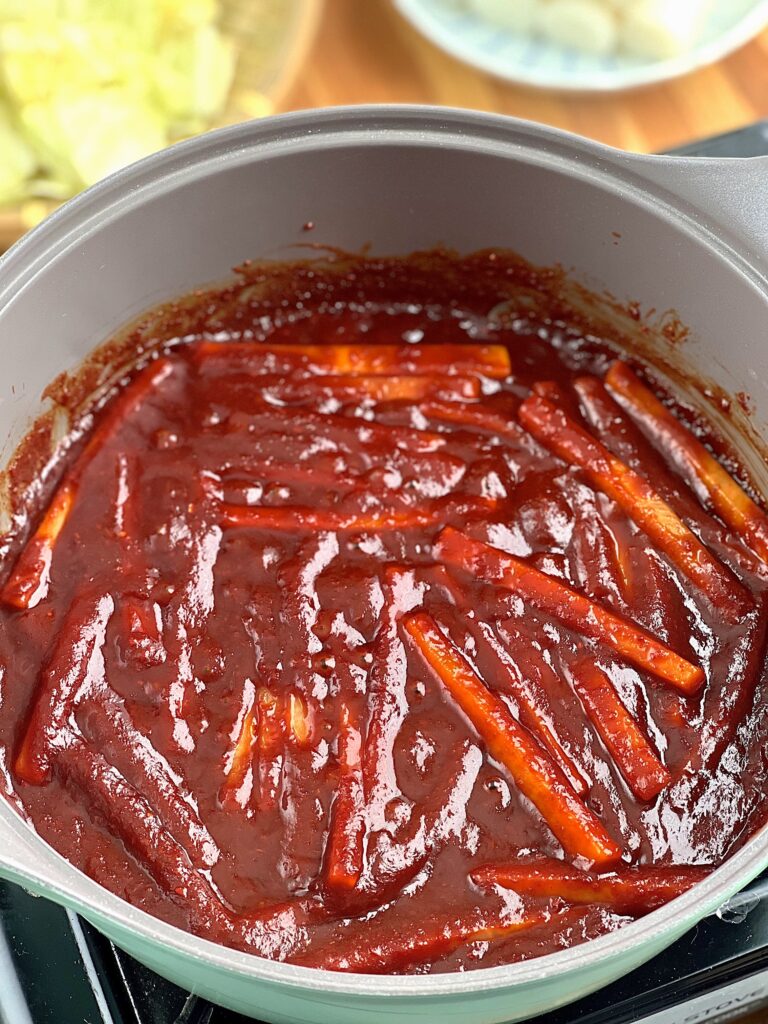
About this recipe
The best tteokbokki I have ever had is Beak Jong Won’s Igane Tteokbokki in Busan, South Korea. My aunt dragged me there one day claiming it was the best but I honestly didn’t have high expectations. To my surprise, she was absolutely right and I was immediately hooked. I went back to that stall so many times during my stay, and I go back every time I visit! I studied that tteokbokki and scoured the Korean internet for the secret to their sauce. It turns out, they make it with Korean radish!
I have sometimes seen thinly sliced carrots in it as well. The recipe I have deleveloped is 100% inspired by their tteokbokki, and I did a ton of research. I was able to develop this recipe using pieces of information I gathered by reading blogs, watching YouTube videos, and referencing pictures I took myself.
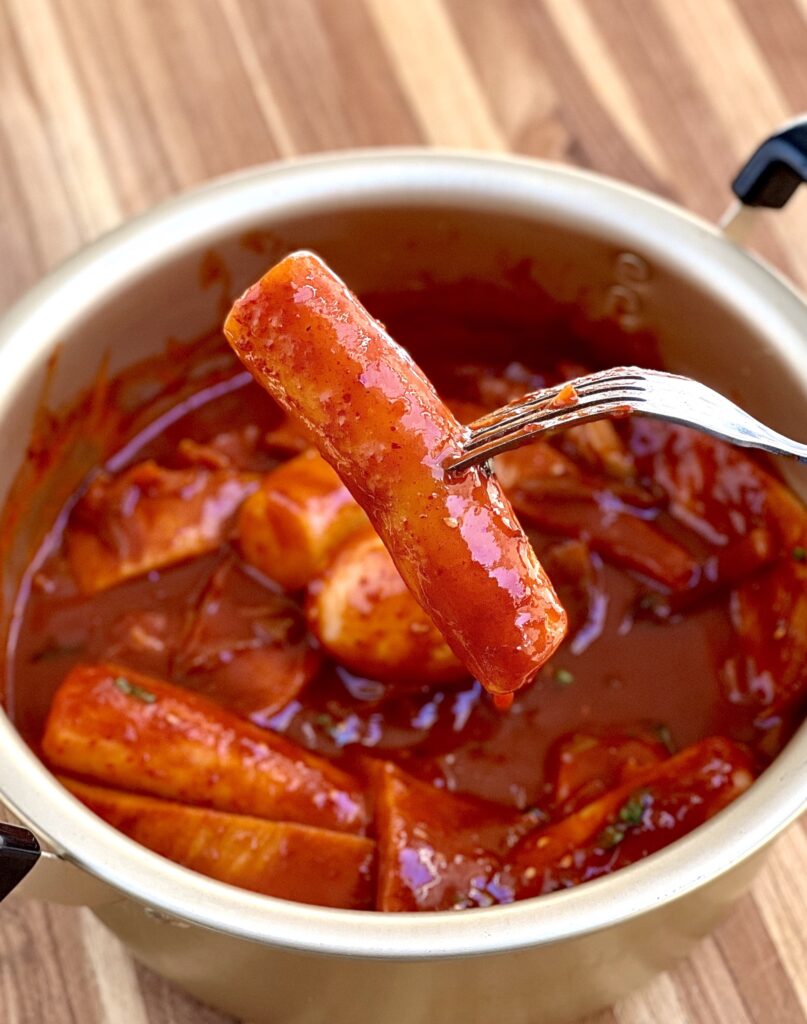
What to look for at the supermarket
You can used refrigerated, vacuum sealed rice cakes but I recommend getting the freshly made ones from a Korean supermarket. The thick ones like the one pictured below are my favorite. You can usually find them at the front where the cash registers are.
For the fishcakes, use whatever shape you like but it is traditionally made with fishcake sheets. You can find this in the refrigerated section where the packaged sausage and pickled items are.
If you don’t feel like making it from scratch but want to try the famous tteokbokki I keep raving about, they package and sell it at Hmart! They don’t always carry it so I make sure to get a few when I do see them. It’s very close to the real thing I highly recommend it!

Ways to enjoy tteokbokki
Tteokbokki is such a popular street food/snack that people have gotten really creative with ways to make and eat it. You can add eggs to it, ramen noodles, and use the sauce as dip for other street foods.
A very common way to eat tteokbokki is any combination with twigim (tempura), mandu (dumplings), soondae (blood sausage), and odeng broth (fish cake broth).
There are also variations of tteokbokki where the sauce is slightly different, like the new rose tteokbokki that has milk to make it creamy. I tried this for the first time a few months ago and it was good but I still prefer the original tteokbokki.
You can add sesame seeds and chopped green onions to make it look nice, but most places in Korea do not add these ingredients. I personally do not care for the flavor it adds, but you may like it!
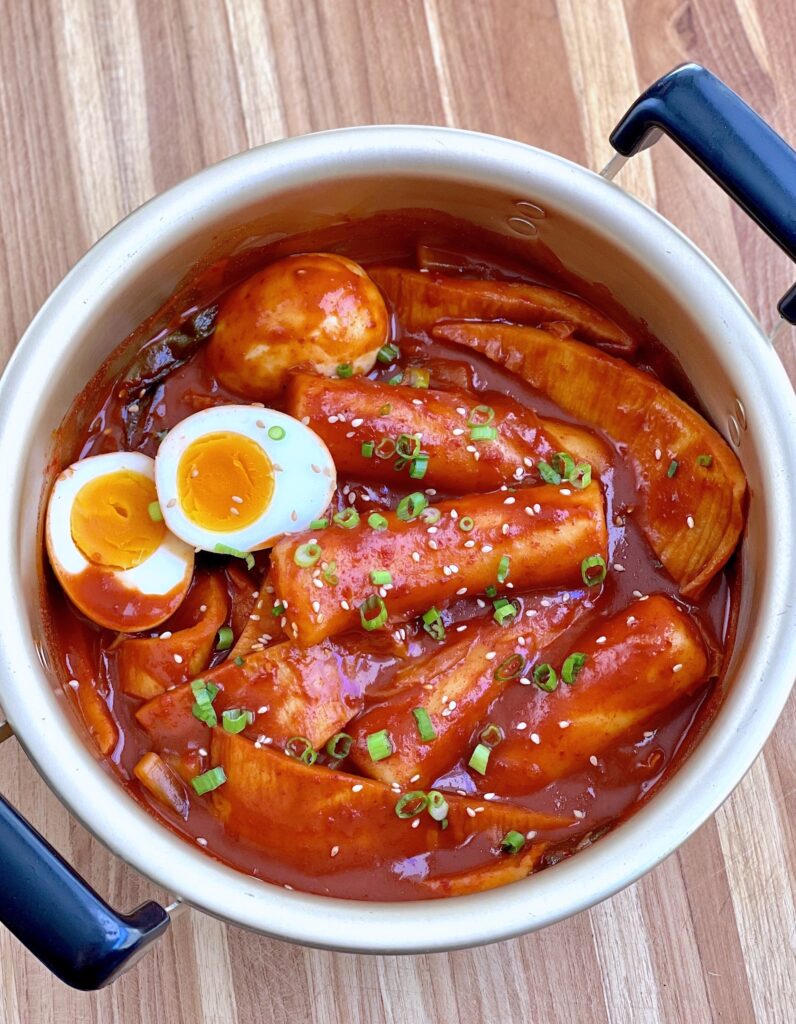

Tteokbokki (떡볶이)- Korean Spicy Rice Cakes
Ingredients
- 1 lb rice cakes
- 5 oz fish cake , (2 sheets)
- 2 hardboiled eggs, optional
- 1/4 tsp msg, optional
Anchovy broth
- 4 cups water
- 6 anchovies, head & innards removed
- 1 4×4 sheet of dried kelp
Sauce
- 1/3 cup extra spicy gochujang, or regular
- 2 tbsp coarse gochugaru
- 2 tbsp fine gochugaru
- 2 tbsp soy sauce
- 1 tbsp light brown sugar
- 2 tbsp oligosaccharide
Veggies
- 1 large green onion, or 3 regular green onions
- 5 oz Korean radish (mu)
- 3 oz cabbage
Instructions
- Prepare the veggies- chop the large green onion and cabbage any way you want, then cut the Korean radish into thin strips.
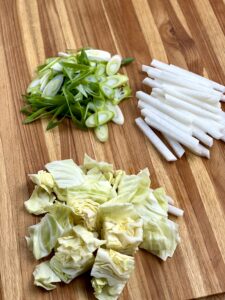
- Prepare the dashi pack- remove the heads and innards from the dried anchovies and put it inside a dashi bag with the dried kelp. You can purchase these at a Korean supermarket or from Amazon here. Note: you don't NEED the dashi bags. Instead you can just boil directly in the water and strain it out after.
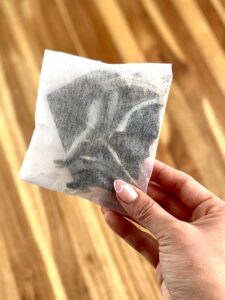
- Simmer in water for 15-20 minutes uncovered, then discard the pack.
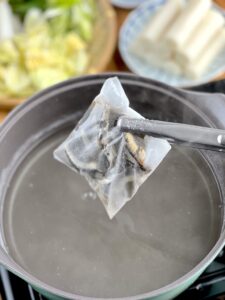
- Set aside most of the broth, leaving just enough broth in the pot to cover the surface area. You should have 2 1/2 to 3 cups of broth reserved.
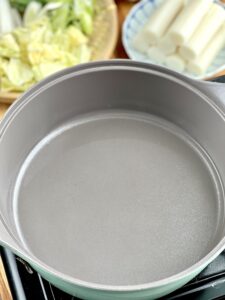
- On low heat. add the Korean radish and the sauce ingredients. Stir fry until the radish softens, and stir frequently to make sure the sauce does not burn.
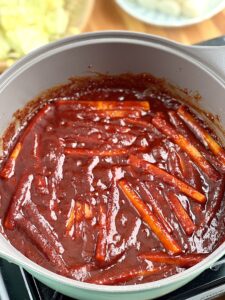
- Add the anchovy broth, cabbage, & large green onion.
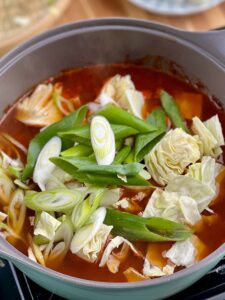
- Bring to a gentle boil. Optional: add a little msg. Most tteokbokki places make it with msg!
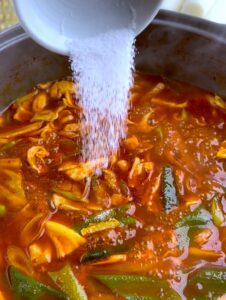
- Add the rice cakes and continue cooking, stirring occasionally, until the sauce has thickened from the starch. This will take roughly 10 minutes depending on the rice cakes you are using.Note: if using packaged refrigerated rice cakes, rinse under cold water first. If using frozen rice cakes, soak in warm water for about 10 minutes before adding.
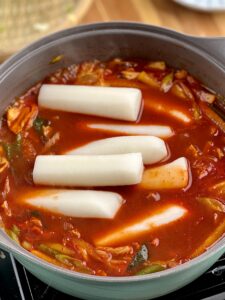
- Rinse the fish cakes under cold water to remove any excess oil, then add them when the sauce has thickened.
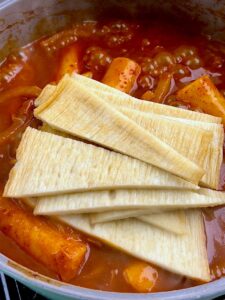
- Cook for another 2-3 minutes then add the hardboiled eggs.
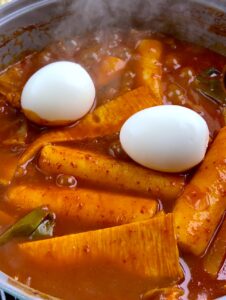
- Toss to coat everything evenly. It is ready when the rice cakes are nice and soft, and are able to hold a lot of sauce.
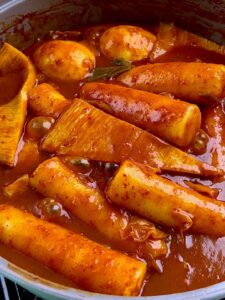
- Optional: top with sesame seeds and chopped green onions.
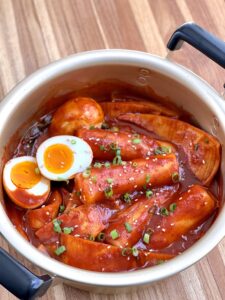
Notes
Nutrition information is automatically calculated, so should only be used as an approximation.
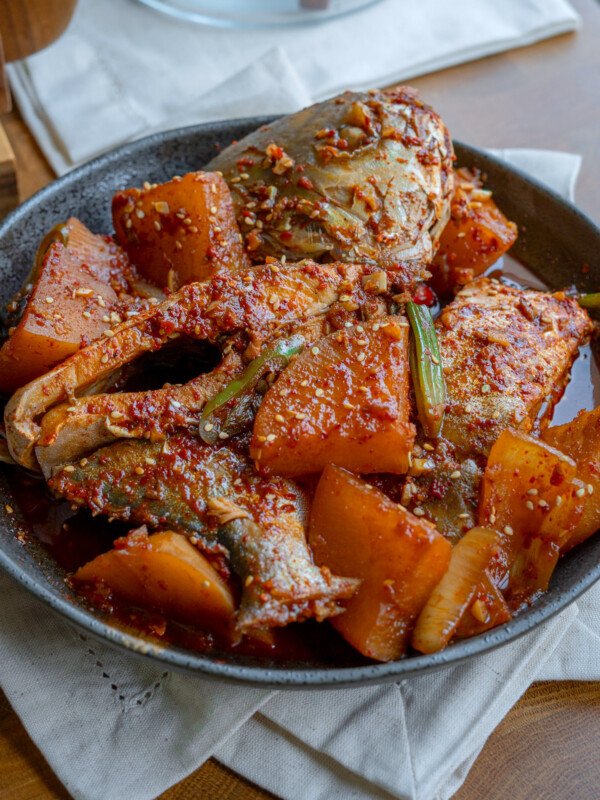
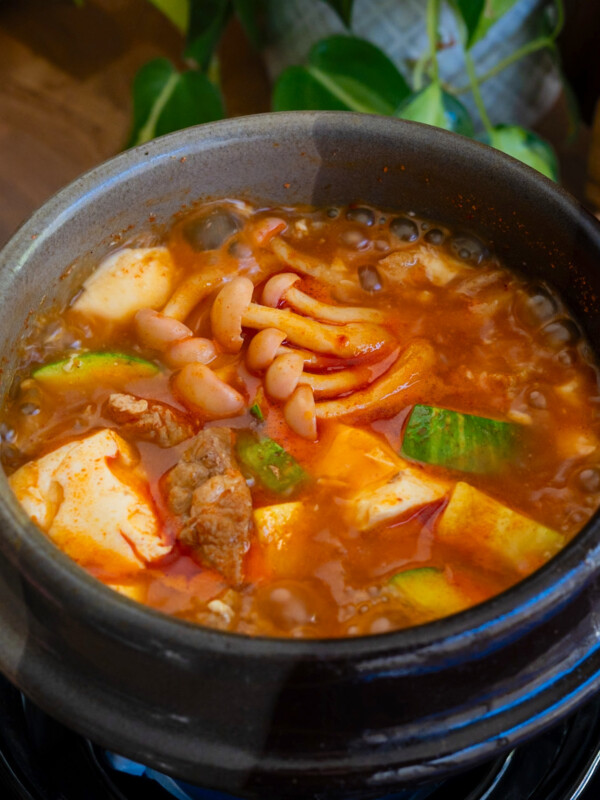
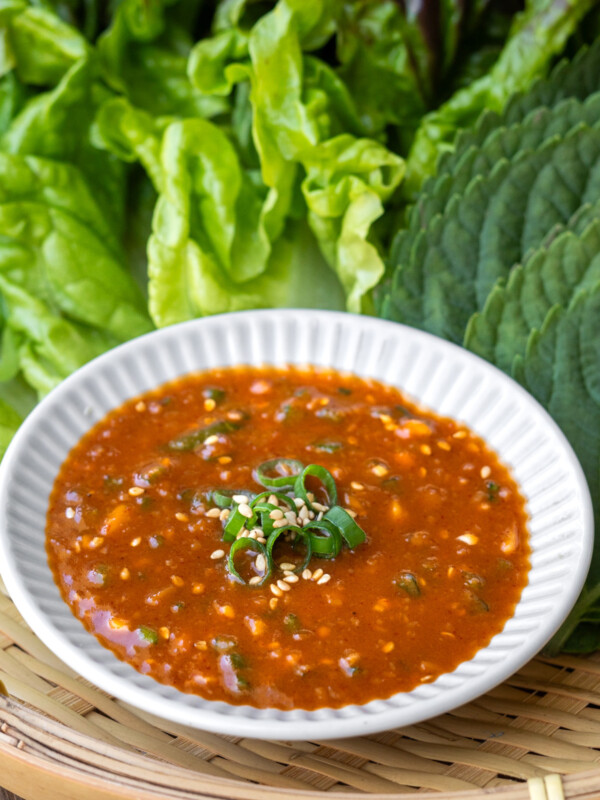
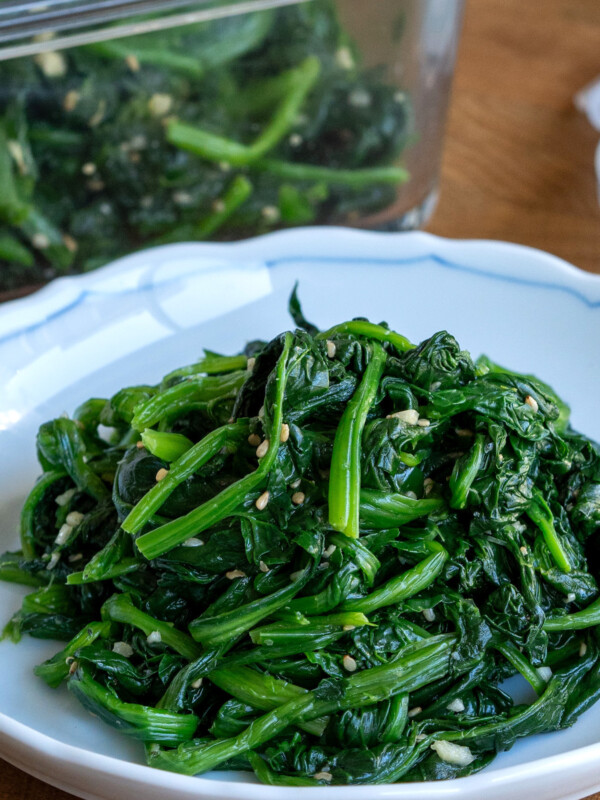







So so so yummy! The recipe was so easy to follow and was delicious!
This recipe is the best tteokbokki recipe. Personally, I love having more vegetables than rice cake but never thought to use radish and its a game changer!! Love making this when having guests over.
I’ve made this recipe a LOT, and it always comes out consistently delicious. It’s one of my favorite recipes, and I remember how thankful I was when you finally shared it. Thank you!
love this recipe! I usually have a hard time w the rice cakes either being too hard and the sauce never thickening / never really tasting quite right! This recipe has alleviated this issue and i am so happy !! Happy eating 🙂
Loved being able to make a dish I love at home so I can swap a few ingredients to meet my allergen needs. This Tteokbokki is so good I make it all the time now.
tteokbokki is my fave and this recipe is so bomb! can’t wait to make it again 🙂
I love you and your recipes. It’s like combining the best cuisines. and this recipe is my all time fav recipe for this classic dish!! As an indian, of course we love anything spicy. So this recipe hit every taste buds and left me craving for more. Thank you for this amazing recipe💕
The rainy weather has me craving tteokboki! I’m going to make this tonight thank you!
I absolutely had to try this one out when I seen it!!!! Sooo delicious!!! 🤤 💣
I also added some noodles to it!
Thank you for the great recipes.
I’m going to my store the get these ingredients and I thought I knew what you meant by oligosaccharide but I totally don’t. I thought it was the mixture of the spicy gochujang the regular the soy sauce and the brown sugar but it appears to be an actual other ingredient? Help? >.<
Hi, thank you for your comment! It’s a sweetening syrup. Sometimes on the bottle you can find it written in English as “oligo syrup.” Rice syrup, corn syrup, honey, or just brown sugar works too 🙂 hope that helps!
I FOUND IT! I’ve got everything measured out and my eggs are boiling wish me luck! <3